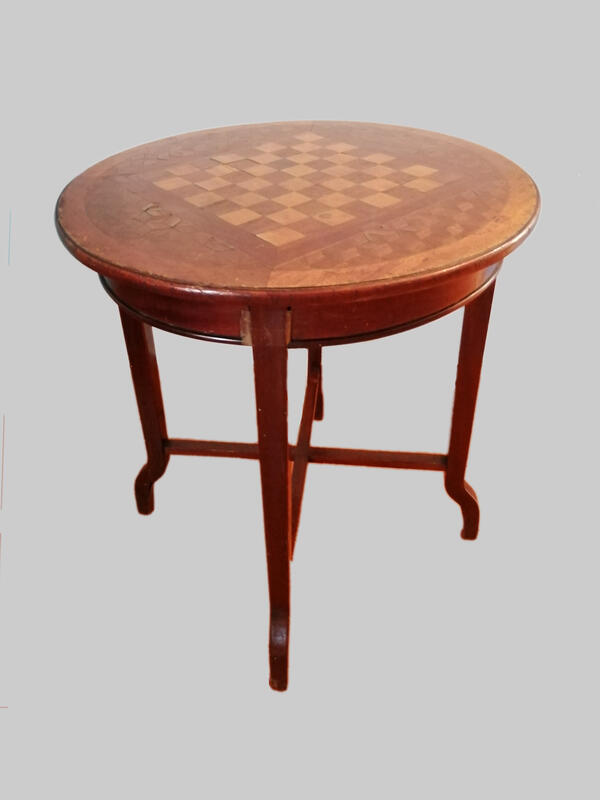In the Aksakov family museum exhibition, among other furniture there is an elegant handmade chess table. It was made at the beginning of the 19th century, its manufacturer is unknown. Inside the table there are two drawers for storing chess pieces, and on the table top there are checkerboard squares: it has everything you need to start playing immediately.
The beauty of a chess table is highly dependent on the decor and design. In antiques, dark squares were made of black ebony, etched pear, mahogany. Birch, ivory and even mother-of-pearl were often used as white fields. Sometimes for playing chess outdoors, the board was made of squares of marble, granite, and basalt. Depending on the tastes and habits of the owner, the chessboard pattern was placed on a library table, a folding gambling or console table. The table displayed at the Aksakov Family Museum is small and looks more like a coffee table for the living room.
We know that the Aksakovs often played chess. The prominent intellectual and writer Sergei Timofeevich Aksakov taught his many children the game. Most likely, this game had a beneficial effect on the development of their thinking: his children Konstantin, Ivan, Grigory and Vera Aksakov went down in history as major literary and public figures, as well as consistent adherents of Slavophilism, a philosophical, literary and partly mystical movement, whose supporters believed that Russia is fundamentally different from Western countries and has a unique future.
In Russia, chess saw widespread recognition as early as the XII-XIV centuries: as a result of excavations, archaeologists discovered chess pieces in about 20% of Russian cities at that time. A particularly large number of figures were found in Novgorod. The popularity of the game in Russia is confirmed by the fact that chess is often mentioned in epics and legends about Russian heroes. They were played by Ilya Muromets, Dobrynya Nikitich, Alyosha Popovich. At the same time, the Russian Church in every possible way prevented the spread of chess and waged a merciless war on them, since chess was considered a so-called ‘demonic game’. This struggle continued until the mid 17th century.
Despite the unspoken prohibitions, boyars, artisans, and representatives of other strata of the population actively played chess. Ivan the Terrible, Peter the First, Alexey Mikhailovich, Boris Godunov loved to spend time at the chessboard. The latter, according to one version, even died while playing chess. This game was also popular at Peter’s assemblies. In the 19th century, chess in Russia was mainly played by the intelligentsia.
The beauty of a chess table is highly dependent on the decor and design. In antiques, dark squares were made of black ebony, etched pear, mahogany. Birch, ivory and even mother-of-pearl were often used as white fields. Sometimes for playing chess outdoors, the board was made of squares of marble, granite, and basalt. Depending on the tastes and habits of the owner, the chessboard pattern was placed on a library table, a folding gambling or console table. The table displayed at the Aksakov Family Museum is small and looks more like a coffee table for the living room.
We know that the Aksakovs often played chess. The prominent intellectual and writer Sergei Timofeevich Aksakov taught his many children the game. Most likely, this game had a beneficial effect on the development of their thinking: his children Konstantin, Ivan, Grigory and Vera Aksakov went down in history as major literary and public figures, as well as consistent adherents of Slavophilism, a philosophical, literary and partly mystical movement, whose supporters believed that Russia is fundamentally different from Western countries and has a unique future.
In Russia, chess saw widespread recognition as early as the XII-XIV centuries: as a result of excavations, archaeologists discovered chess pieces in about 20% of Russian cities at that time. A particularly large number of figures were found in Novgorod. The popularity of the game in Russia is confirmed by the fact that chess is often mentioned in epics and legends about Russian heroes. They were played by Ilya Muromets, Dobrynya Nikitich, Alyosha Popovich. At the same time, the Russian Church in every possible way prevented the spread of chess and waged a merciless war on them, since chess was considered a so-called ‘demonic game’. This struggle continued until the mid 17th century.
Despite the unspoken prohibitions, boyars, artisans, and representatives of other strata of the population actively played chess. Ivan the Terrible, Peter the First, Alexey Mikhailovich, Boris Godunov loved to spend time at the chessboard. The latter, according to one version, even died while playing chess. This game was also popular at Peter’s assemblies. In the 19th century, chess in Russia was mainly played by the intelligentsia.



